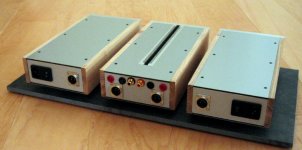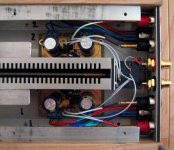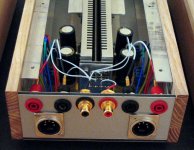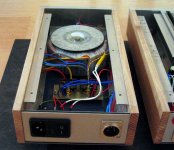Peter,Peter Daniel said:But what I find particularly interesting is the way potentiometer is mounted and shaft extender run between the heatsinks (including the cutout in top panel).
What is he using the potentiometer for? Is it just an input signal attenuator? (looks like an Alps?)
The twin external PSUs may be a bit of overkill, but it looks great! Is he using a regulated, or snubberized PSU in each one.....or just the rectifier boards? Any pics inside the PSUs?
The design is extremely nice, and very carefully executed. Very reminescent of some of your incredible case work. Those have to be the shortest heatsink fins I've ever seen, but the effect is stunning!
Robert
Peter Daniel said:The difference between dual mono and stereo is the number of rectifier boards used in powering the amp. In stereo, both channels are powered from the same board, in dual mono each channel has its own separate board.
While in stereo setups with a single transformer you could still use two separate boards, on more than one occasion I had reports of humming supply so I always recommend using a single rectifier board.
That's also what I'm doing in all my stereo amps and in the picture below I'm showing trouble free way to connect power grounds: output grounds of both channels (OG) are connected with a piece of thick copper wire. Central point on that wire is power star ground and all 4 ground wires from rectifiers board (PG+, PG+ and PG-, PG-) are connected here. Output grounds are taken directly from the board, signal ground connects to the point on the board marked as SG.
Those boards were designed with dual mono operation in mind and as such they work well without any mods.
I dont get it, so i need to ground PG+, PG- and both OG with an 10R resistor.
Mr_Empa said:
I dont get it, so i need to ground PG+, PG- and both OG with an 10R resistor.
PG+, PG- and OG are all connected on amp board (with ground plane). The chassis is usually connected to earth ground (third pin from AC connector) and the amp ground connects to the chassis through 10R resistor.
eVITAERC said:How is the buffer coming along? I'm dying to get my hands on a nice buffer for my Monica 2, especially since I modded the I/V stage to use something more sane than a simple resistor.
Some of the parts are special order from Digi Key. I will try to deal with it this week (including Dales from Mouser), so probably end of next week I might have some kits available. From what I hear now, with my test unit, this is a very good sounding circuit.
It's really hard to say what would be the best: it shouldn't be too low, and shouldn't be too high, maybe 22k would be a good choice?
After all, it's close to what Placette is using in active version of what is claimed to be the finest linestage available: http://www.placetteaudio.com/active_line.htm
I'm presently using their passive volume control unit and it's indeed very good, actually better then a single series Vishay ( or Caddock TF020) with a DACT in shunt position.
After all, it's close to what Placette is using in active version of what is claimed to be the finest linestage available: http://www.placetteaudio.com/active_line.htm
I'm presently using their passive volume control unit and it's indeed very good, actually better then a single series Vishay ( or Caddock TF020) with a DACT in shunt position.
Peter Daniel said:
PG+, PG- and OG are all connected on amp board (with ground plane). The chassis is usually connected to earth ground (third pin from AC connector) and the amp ground connects to the chassis through 10R resistor.
Approximatly how many watt does the 10R resistor need to handle?
DAC Receivers
I used a socket for the receiver on my Greenboard DAC so I could compare the CS8412 and the CS8414.
I can hear no difference at all between the two. Of course I can not do a true A-B comparison because I only have the socket on one Greenboard, so I have to listen to them one at a time by changing recievers back and forth....not the best comparison.
I guess I could compare the CS8414 in the Greenboard with the CS8412 in one of my All-In-Ones using my A-B switch, but some of the other components are different as well.
Robert
Peter,Peter Daniel said:It should be compatible. Some say CS8412 is better, but I never really compared both chips.
I used a socket for the receiver on my Greenboard DAC so I could compare the CS8412 and the CS8414.
I can hear no difference at all between the two. Of course I can not do a true A-B comparison because I only have the socket on one Greenboard, so I have to listen to them one at a time by changing recievers back and forth....not the best comparison.
I guess I could compare the CS8414 in the Greenboard with the CS8412 in one of my All-In-Ones using my A-B switch, but some of the other components are different as well.
Robert
An externally hosted image should be here but it was not working when we last tested it.
An externally hosted image should be here but it was not working when we last tested it.
Hey Peter where did you get those blocks of copper you used in several installations?
I am planning on my amplifier and have decided to go with an acrylic case. I want to use two copper blocks. I was planning on one copper block to separate the transformer and channels, and one more to separate the channels. I also have a damping pad for the transformer. I guess the last question is where to buy copper sheet to wrap the transformer in and a piece for the top?
I am planning on my amplifier and have decided to go with an acrylic case. I want to use two copper blocks. I was planning on one copper block to separate the transformer and channels, and one more to separate the channels. I also have a damping pad for the transformer. I guess the last question is where to buy copper sheet to wrap the transformer in and a piece for the top?
Peter Daniel said:I buy copper from Metal Supermarkets.
Do you order it in? I don't see that size buss stock in the Vancouver area stores but might just be missing it.
Peter, don't know if you've been following the 'Blowtorch' thread in Solid State but someone posted this approximate schematic of the power supply:
http://www.diyaudio.com/forums/attachment.php?s=&postid=823671&stamp=1137934683
What do you think of the pre-regulator handling of the dual secondary transformer? Has the dual full bridge + common mode choke layout been tried with your Gainclone boards yet? Worth a shot?
I never order on line, I go to the store and ask them to order for me, if it's out of stock. This size bar is indeed rare and not common stock.
Regarding the preregulator filtering in Blowtorch, I'm using exactly same configuration in a DAC (with addition of 20R series resistors tight after chokes) and it works very well.
I'm not sure if it would work in a GC, as current draw is changing depending on the power. Besides, the GC PS arrangement seem to work well already ( it is better than batteries), however, it never hurts to try.
Regarding the preregulator filtering in Blowtorch, I'm using exactly same configuration in a DAC (with addition of 20R series resistors tight after chokes) and it works very well.
I'm not sure if it would work in a GC, as current draw is changing depending on the power. Besides, the GC PS arrangement seem to work well already ( it is better than batteries), however, it never hurts to try.
Peter Daniel said:....it never hurts to try.
Thanks Peter, I might just breadboard this circuit up after finishing another project and give it a listen.
- Status
- This old topic is closed. If you want to reopen this topic, contact a moderator using the "Report Post" button.
- Home
- More Vendors...
- Audio Sector
- AudioSector-chip amp kits, dacs, chassis




